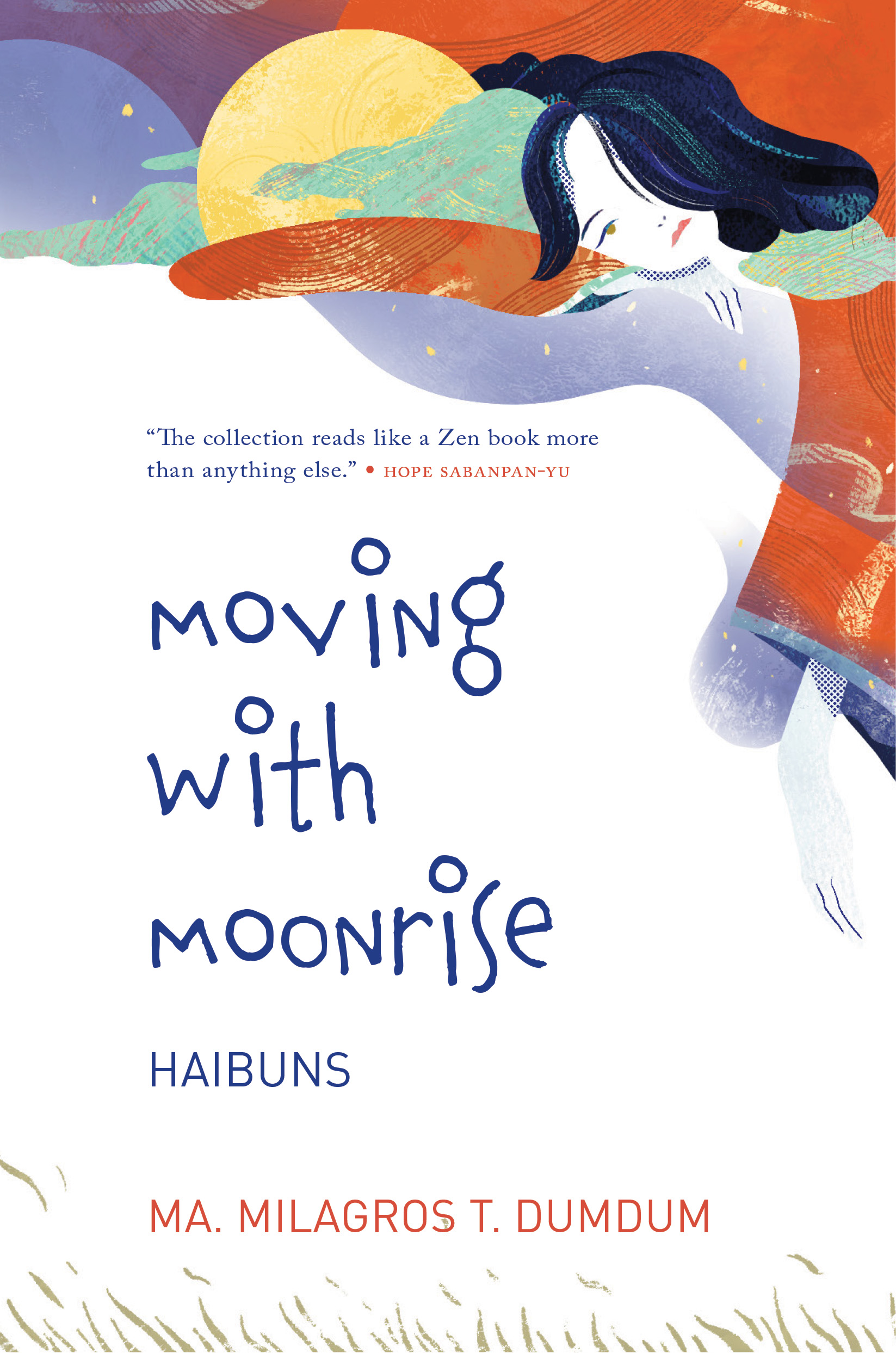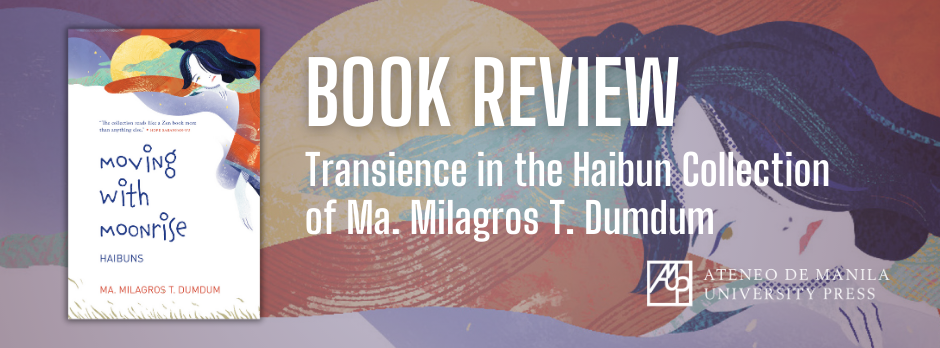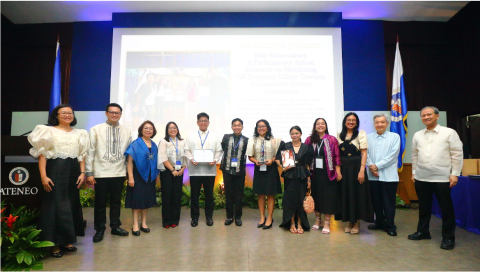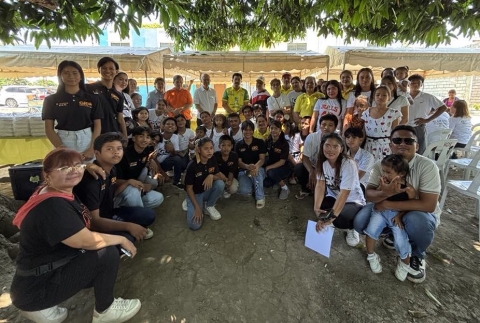[Book Review] Moving with Moonrise: Haibuns by Ma. Milagros T. Dumdum
19 Feb 2024 | Marjorie Evasco-Pernia
Transience in the Haibun Collection of Ma. Milagros T. Dumdum
By Dr. Marjorie Evasco-Pernia
In 2018, Ma. Milagros T. Dumdum’s first poetry collection, Falling on Quiet Water (Bathalad)—comprised of a sequence of 123 haiku—began her poetic journey (ironically prodded by a lower-back injury) which brings her and us, her readers, to her 2023 collection of 56 haibun titled Moving with Moonrise (AUP). Within this span of five years, she and her lifetime poet-partner Simeon Dumdum, Jr., also published a collection of renga titled The Sigh of a Hundred Leaves (San Anselmo Press, 2020).
What we noted as an enthusiastic appropriation of the Japanese poetic form five years ago is illuminated in the haibun collection as her masterful handling of this Japanese poetic form yoking brief travel notes with haiku inspired by space-time specifics of the journey. Simeon Dumdum, Jr. says in his introduction to the book that Ma. Milagros T. Dumdum’s travel diary “hews to the spirit of Basho’s Narrow Road to the Interior…the interior, however, as not a physical but a spiritual heartland, the heartland of memory, of the contemplation of beauty and time, of solitude and longing.” (xviii)
While some readers may ask, “Why use Japanese poetic forms?” my considered reply is “Why not?” It’s not as strange as it may seem. Its brevity is akin to the brevity and wit of the tigmo in Visayan poetry that seeks to capture the ineffable in every thing. I also suspect that the strict form of the haiku is a most difficult discipline that lures poets worth their salt to try doing their sleight of hand skills with. Among the literary forms, it is poetry that upholds the power of luminous crystalized language, where less is definitely more.
As an avid reader of Ma. Milagros T. Dumdum’s poetry, I read her haiku in Falling on Quiet Water as her way of generously sharing “the best way of releasing the catch in memory’s lock, and as if by magic, see things come alive again in our imagination.” In Moving with Moonrise, she once again graciously shares with her readers an intimate diary of her personal sojourn through life, marked by well-lighted images and scenes held tenderly and surely by the haiku form. Thus, I read this haibun collection as creative nonfiction poetry, given that her interior landscapes have actual references to experienced or lived-through terrains of her rich and accomplished life.
Place and memory dance together on the pages of this collection which begins with the poetics of dancing with, the plural personae practicing the aesthetics of balance in the foxtrot. The dominant sounds of the haiku— sibilants and long ō’s — embody the smooth flowing movements of the pair across the dance floor while the big band is playing, say, “A Fine Romance” of Louis Armstrong, or Benny Goodman’s “Taking a Chance on Love.”
We dance the foxtrot:
Slow, slow, quick, quick, let it go—
The sea’s ebb and flow
And the last line’s metaphoric figure of the ebb and flow of the sea does not only refer to the pair’s dance movements, but also transforms the dance floor itself, thus the importance of the equipoise achieved by the dance partners.
In haibun #16, Ma. Milagros T. Dumdum meditates on the interior landscape of her art practice:
If haiku comes, as sometimes it does, it is a gift! Otherwise, I am, by choice, pro-active, I sharpen my awareness of triggers right before me or lurking somewhere waiting for my attention— everything is potential material for a haiku aching to be born. And the haiku that accompanies this travel note is more than an illustration of the practice of honing her awareness; it is a demonstration of the practice or act of shaping the material of one’s art:
With garden scissors
Into a parabola
He shapes the bushes
Now, of course, the metaphoric figure of the parabola has rich implications on her praxis of the haibun. I would hazard a wild notion that the parabola is an umbral force organic to her deft tangential approach to remembered experience.
Haibun #19 embodies best this way of looking that refreshes the eye and astonishes the heart. Marking her home province Leyte, her childhood days spent in Ormoc City, she recalls school vacations, the exhilarating freedom of “mountain treks…hide and seek games, sleeping on mats spread out on bamboo floors, evenings lighted by kerosene lamps, drawing water from a deep well.” The vivifying water she draws up from this living reservoir of time transforms the re-membered experience into an incandescent moment of existential awareness— akin to what zen masters call satori:
Looking down the well—
Water, dark and bottomless,
I can’t see my face.

Moving With Moonrise: Haibuns by Ma. Milagros T. Dumdum is published by the Ateneo de Manila University Press under the Bughaw imprint. The book retails at PHP 250 and is available at the Ateneo University Press Bookshop in Bellarmine Hall, and the Press’s official Lazada and Shopee stores.
Category: Poetry
Language: English
Price: PHP 250
Get your copy in paperback: website │ Lazada and Shopee







